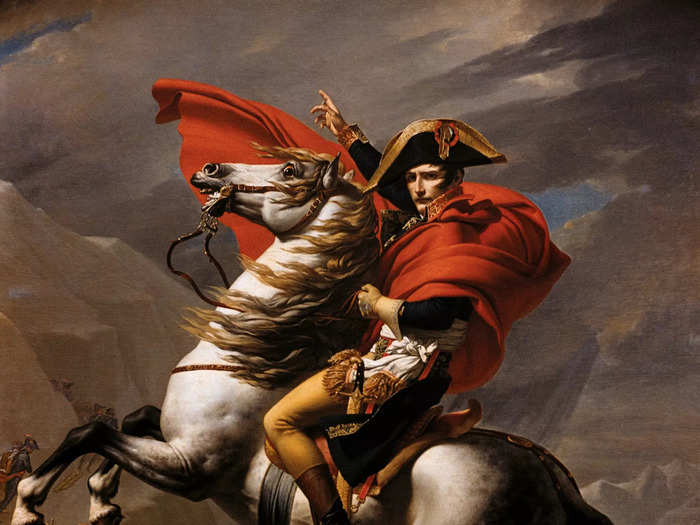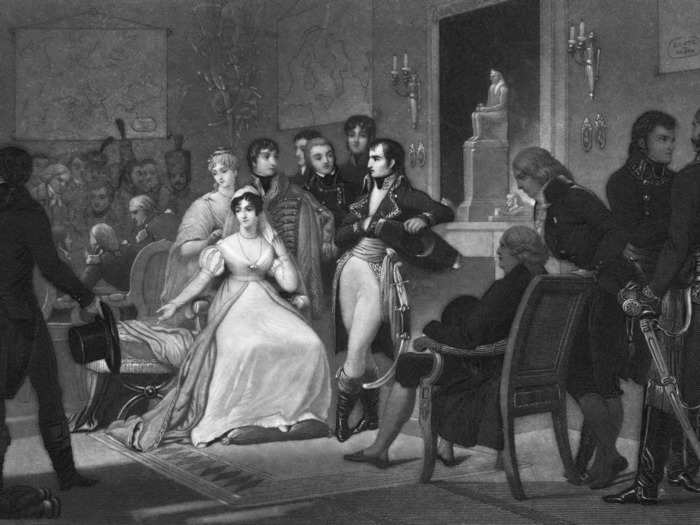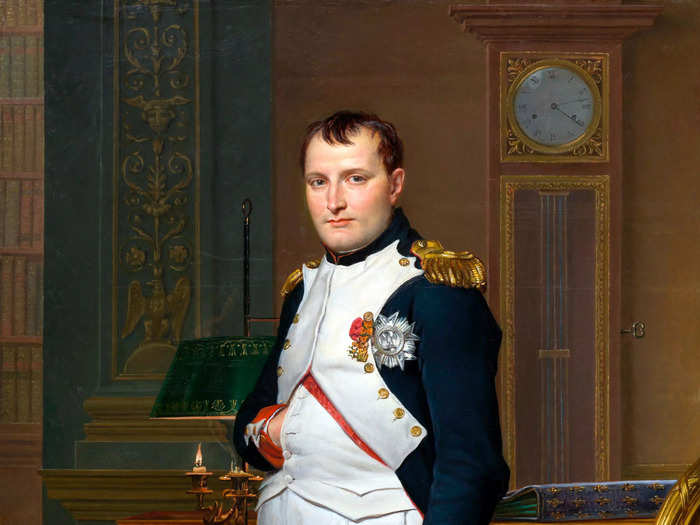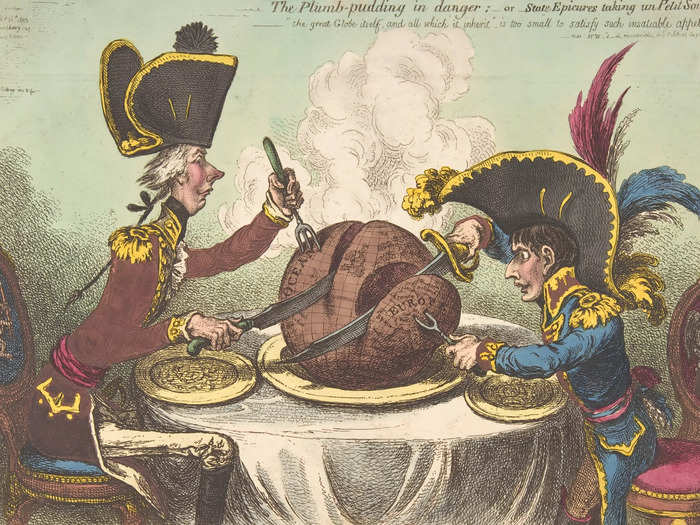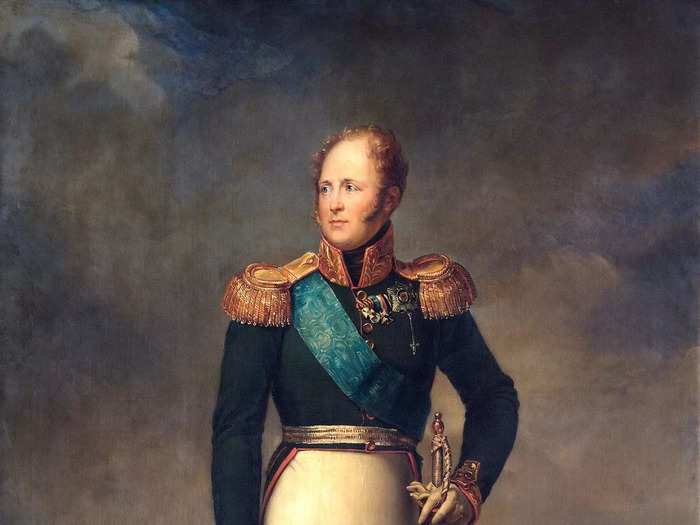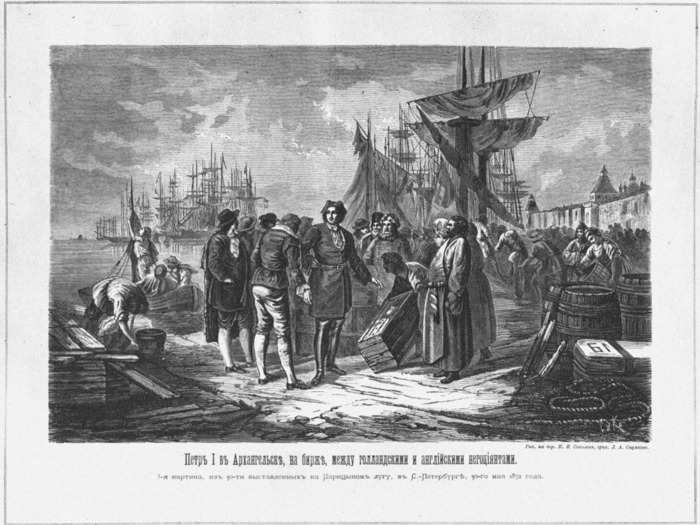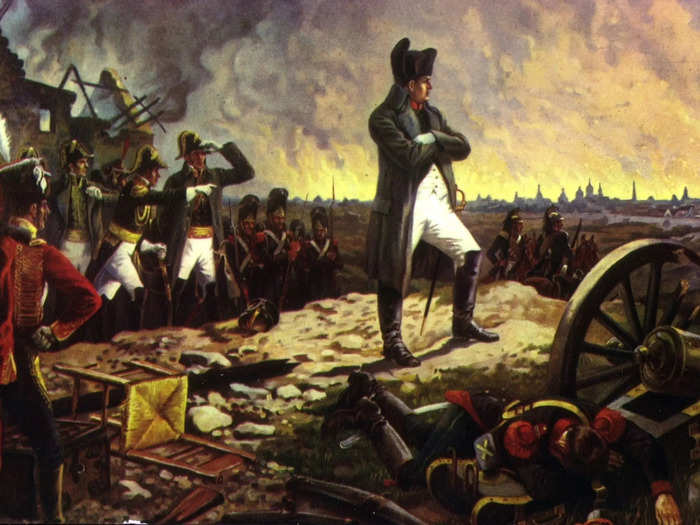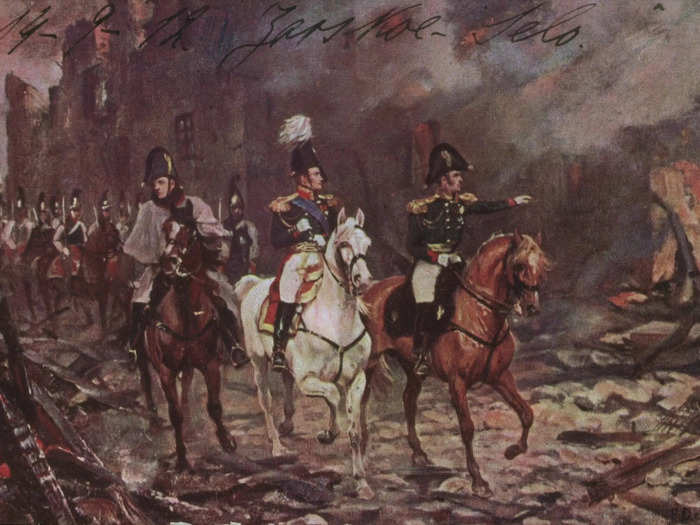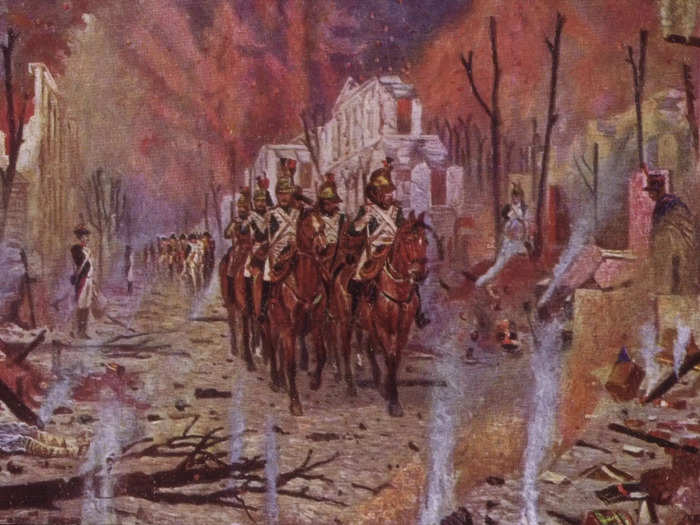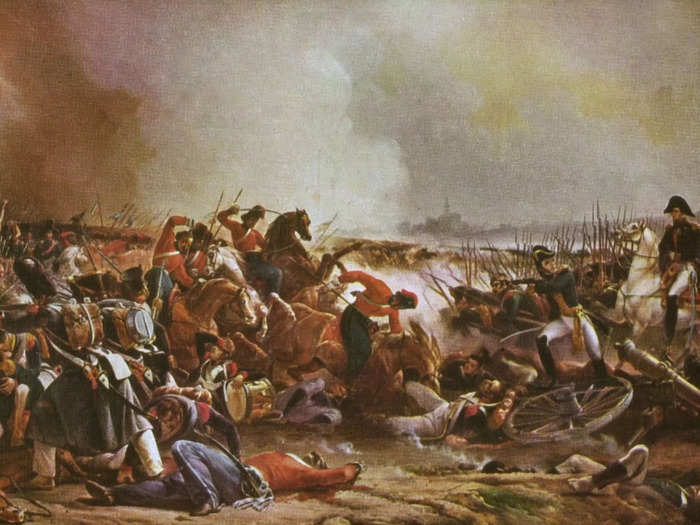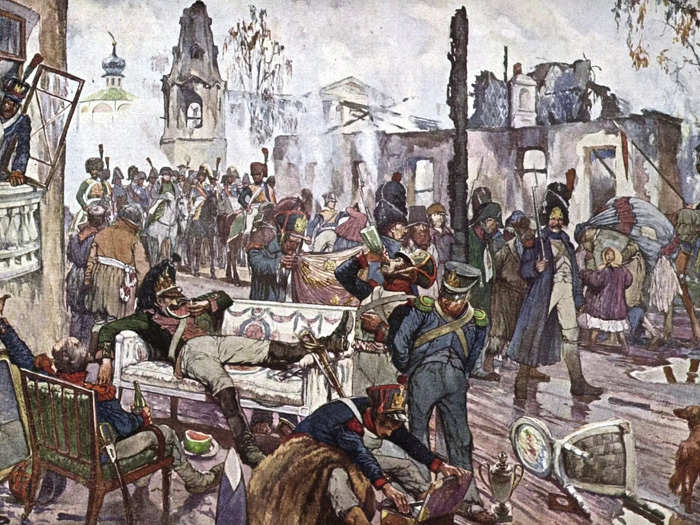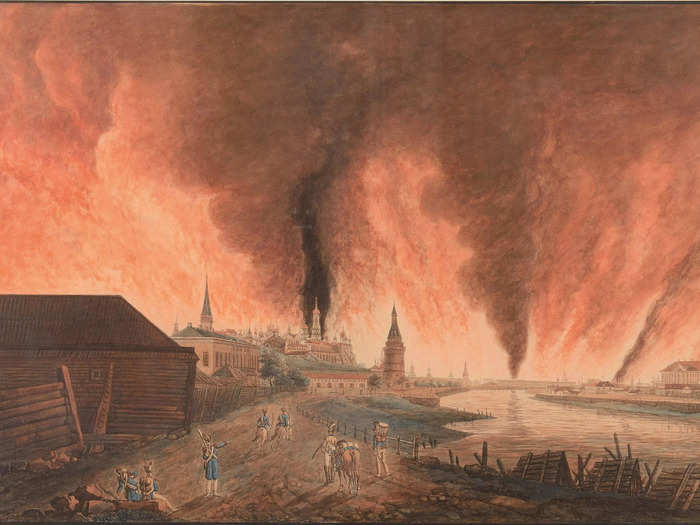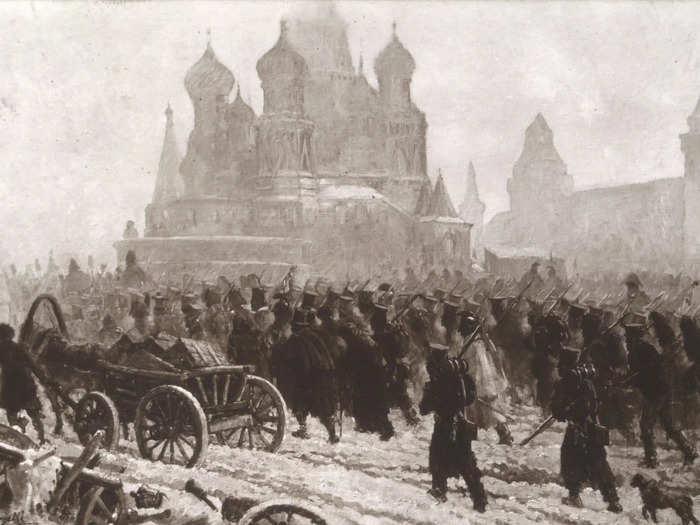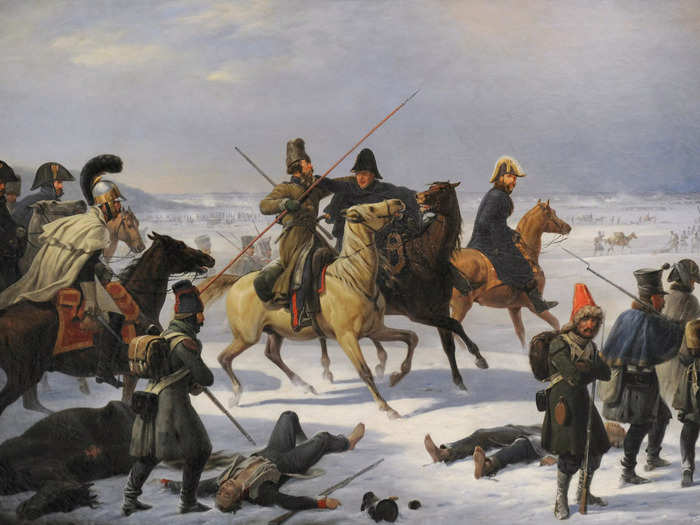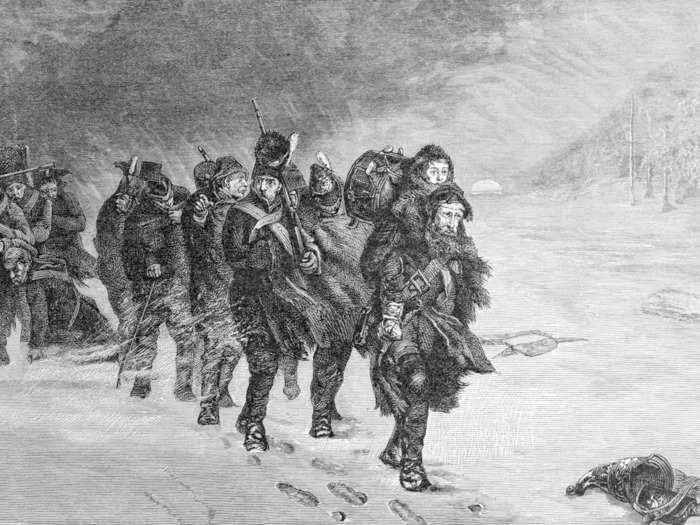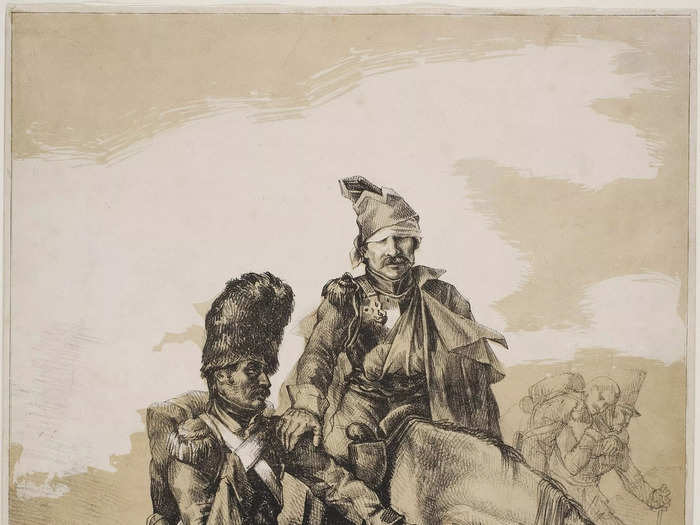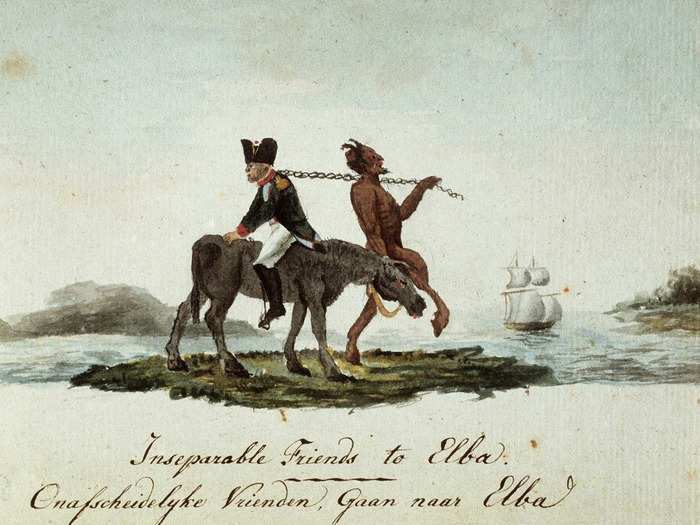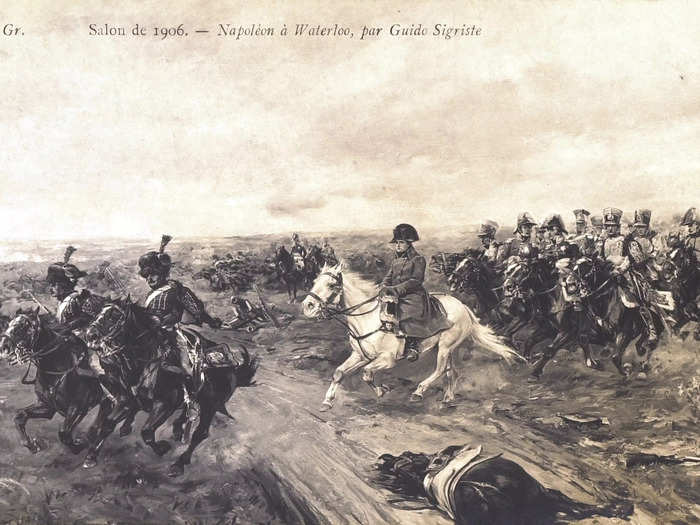An etching of Napoleon Bonaparte and his army retreating from Russia after a failed invasion.Hulton Archive/Getty Images
- When Russia began illegally trading with England, Napoleon prepared to invade Russia.
- Napoleon amassed an army of 600,000, the largest army Europe had ever seen.
After a coup d'etat of the French government in 1799, Napoleon Bonaparte began his conquest of Europe. By 1804, Bonaparte had made himself the emperor of France and was quickly amassing power.
By 1812, Bonaparte controlled territory from Iberia, Spain, to the banks of the Nemen River in Russia. Because he could not take control of Great Britain, he initiated the continental system, a blockade that prevented the British from trading with the rest of Europe.
The blockade negatively impacted Russia, which then began illegally trading with Britain, leading Bonaparte to worry about possible allyship between the two countries.
In June 1812, Bonaparte invaded Russia, aiming to deal a decisive blow and force Alexander I into peace talks.
Through a series of strategic retreats and slash-and-burn techniques by the Russian army, in addition to the harsh Russian winter, the largest army Europe had ever seen found themselves retreating from Moscow.
The French Grand Army faced severe losses, and the campaign into Moscow severely weakened Bonaparte's grasp on power and is widely attributed as the beginning of the end of his rule.
Napoleon Bonaparte was a French military leader who rose through the ranks during the French Revolution.
A portrait of Napoleon Bonaparte riding his horse at the St. Bernard Pass. Francis G. Mayer/Getty Images
He graduated from a French military academy in 1785 and became a second lieutenant in an artillery regiment of the French army.
In 1795, Bonaparte helped suppress a royalist insurrection and was promoted to Major General.
In 1799, Bonaparte led a coup and successfully overthrew the French Directory.
An engraving of the morning of the 18th Brumaire, the day Napoleon Bonaparte became the ruler of France. Bettmann/Getty Images
In 1802 Bonaparte made an amendment to the constitution, making him the first Consul for Life and granting him dictatorial powers over France.
In 1804, Bonaparte crowned himself the Emperor of France, a little under 10 years after the French had beheaded their last king.
After he was crowned Emperor, Bonaparte began his conquest of Europe.
A portrait of Napoleon Bonaparte in His Study at the Tuileries, 1812. Fine Art/Getty Images
Bonaparte took control of Belgium, Holland, and large swaths of present-day Italy, Croatia, and Germany. Spain was mostly under his control, while Russia, Austria, and Prussia were begrudging allies.
In 1812, the French empire had reached its maximum size stretching from Iberia in Spain to the banks of the Nemen River in Russia.
The only place that resisted Bonaparte's advances was Great Britain.
The invasion of Russia began with Bonaparte's Continental System.
An illustration shows William Pitt and Napoleon Bonaparte carving a large plum pudding on which is a map of the world, with Pitt's slice larger than Napoleon's. Heritage Images via Getty Images
During his reign of most of Europe in the early 1800s, Napoleon enacted the Continental System designed to punish his British enemies, a large-scale embargo against the British Empire.
Because he was unable to invade and control Britain, the next best thing would be to prevent them from doing trade with the rest of Europe.
The system successfully prevented the British from trade, but also proved to be economically harmful for the Russians.
Portrait of Alexander I of Russia. A. J. Photographics via Getty Images
To help out their economy, Russia defied the Continental System and resumed trading with Britain.
An engraving of Peter I in Arkhangelsk between the Dutch and English merchants Heritage Images via Getty Images
Upon learning of Russia's illegal trading, Bonaparte began preparing for invasion.
The French invasion of Russia of 1812 Culture Club via Getty Images
Napoleon gathered an army of 600,000 men to invade Russia and work their way toward Moscow.
Napoleon's army was the largest that Europe had ever seen. Of the 600,000 men, only half of them were from French.
The other half was made up of men from Germany and Poland, countries under French control in 1812.
The invasion of Russia began in June 1812 and lasted six months.
Bonaparte looks over the battlefield on his way to Moscow. Photo12/Foundation Napoleon/Universal Images Group via Getty Images
The invading French army started at several different points to invade Russia. The army that gathered with Napoleon was a force of roughly 227,000 soldiers.
The rest of the army was split across the Russian border with a French reserve of 225,000 waiting behind the lines.
The Russians proved to be elusive and incrementally led the French further into Russian territory.
Napoleon rides through a burned city on horseback with his army at his back. Photo12/Foundation Napoleon/Universal Images Group via Getty Images
Napoleon was after a quick victory that would bring Alexander I, the ruler of Russia, to the negotiation table.
However the constant retreats by the Russian army prevented a decisive victory for the French.
Instead of fighting the French head-on, the Russians employed a strategic retreat.
Napoleon Bonaparte's army marches through a burned city. Photo12/Foundation Napoleon/Universal Images Group via Getty Images
The Russians were outmatched by 200,000 to 600,000 and knew a head-on fight wouldn't be productive.
During each encounter with the French army, the Russians would retreat. On their way out, they would burn bridges, food supplies, and shelter, leaving behind nothing but ashes.
The French were allowed small victories and gains of territory, but each advance came with a steep cost.
As the French continued their advance, food for horses and humans began to run low.
The first major battle of the invasion of Russia wouldn't take place until a month into the operation.
Battle of Smolensk during the French Russia Campaign. Photo12/Foundation Napoleon/Universal Images Group via Getty Images
The Battle of Smolensk, a town 230 miles west of Moscow, was the first major battle between the Russians and the French. Smolensk was a city of major significance to the Russians, and they wouldn't let it go as easily as the other territories.
Nevertheless, the Russians retreated further into Russia to avoid major losses to their army, burning bridges and ammunition stores on their way out of the city.
By the end of the battle, all that was left for Napoleon was the ashes of a city and thousands of dead soldiers.
Napoleon and his army finally arrived in Moscow on September 14, 1812.
A painting of the French capture of Moscow on September 14, 1812. Photo12/Foundation Napoleon/Universal Images Group via Getty Images.
By the time they arrived, Moscow was a ghost town. Most of the city had evacuated, and the Russian army had burned most of it down.
A painting of Moscow on fire as the Napoleonic army approaches. Fine Art Images/Heritage Images/Getty Images
Napoleon sent a letter from Moscow to Alexander I inviting him to make peace, however, no response was ever received.
After five weeks in Moscow, Napoleon's army began their withdrawal, fearing a cold winter.
The Grand Army begins its withdrawal from Russia. Photo12/Foundation Napoleon/Universal Images Group via Getty Images
On their way out, the army comprising of an estimated 100,000 survivors was attacked by the Russians.
The Grand Army is attacked during their retreat from Moscow. Prisma/Universal Images Group via Getty Images.
The Battle at Maloyaroslavets resulted in a short-term victory for the French, with the Russians ultimately retreating.
The long-term victory, however, went to the Russians. After the battle of Maloyaroslavets, Napoleon decided to change routes.
Instead of continuing south on a path with warmer weather and more supplies, he took his army back the way they came. The path was 260 miles through ransacked and scorched villages, which offered no food or shelter during the cold winter.
The weather, lack of food, and repeated attacks by the Russian army further weakened Napoleon's army.
French Emperor Napoleon Bonaparte and the Grande Armee flee the pursuing Russian army in the snow on the retreat from Moscow. Hulton Archive/Getty Images
The retreat was punctuated by an early winter with high winds, below-zero temperatures, and a lot of snow. With little to no shelter, there were nights when thousands of soldiers and horses died from exposure to cold.
What was left of the Grand Army eventually made it out of Russia and returned back to France.
Retreat of the French Army After the Russian Campaign. Bettmann via Getty Images
By December 1812, Napoleon left his dwindling army and retreated to Paris.
After the invasion, Napoleon's power was significantly weakened.
Soldiers retreat, injured and sick, from Moscow. Fine Art Images/Heritage Images/Getty Images
In the six months it took to invade and retreat from Russia, it is estimated that of the 600,000 soldiers that entered Russia, only 112,000 returned.
Amongst the casualties, 100,000 are believed to have died in action, 200,000 died from other causes, 50,000 were left sick in hospitals 50,000 deserted, and an estimated 100,000 are believed to have been taken as prisoners of war.
By comparison, Russia's casualties numbered at 200,000 killed, 50,000 dispersed or deserting, and 150,000 wounded.
Identifying the weakness in France's military, Russia, Austria, Prussia, the United Kingdom, Sweden, Portugal, Spain, and several German states formed the Sixth Coalition and defeated the First French Empire.
After these significant losses, Napoleon was exiled to the island of Elba.
The devil guides Napoleon Bonaparte into exile on the Island of Elba. Fototeca Gilardi/Getty Images
In 1815, Napoleon escaped exile and tried to regain control during the Battle of Waterloo.
Napoleon I at the Battle of Waterloo after returning from exile. Foundation Napoleon/Photo12/Universal Images Group via Getty Images
However, despite his best efforts, Napoleon never rose to power again.
After his loss at Waterloo, Napoleon was again exiled to the Island of St. Helena, where he lived out his life and died at the age of 52.

